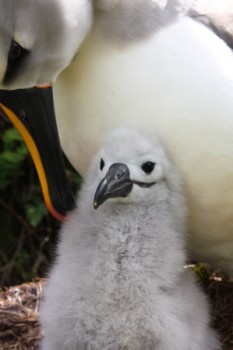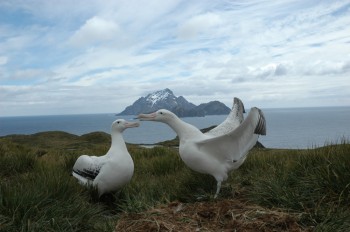Albatross Island (c. 100 ha) lies in the Bay of Isles towards the northern end of South Georgia (Islas Georgias del Sur)* in the South Atlantic.
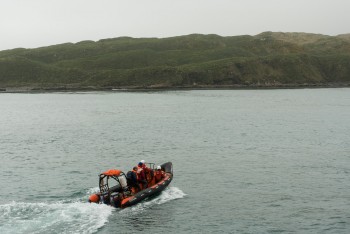
Approaching tussac-covered Albatross Island, photograph by Anton Wolfaardt

North-east Point on Albatross Island
The island’s vegetation is made up primarily of Tussac Grass Parodiochloa flabellata. Unlike nearby Prion Island, Albatross Island is not open to tourism. Although listed as a Specially Protected Area (SPA) it has not been formally so designated. A permit is required to make a landing and a Code of Conduct has to be followed. Albatross Island has been closed to all but researchers since 2004 and permits are issued only "under exceptional circumstances". Unlike the nearby main island of South Georgia (Islas Georgias del Sur)*, Albatross Island has remained rodent free.
Annual visits to monitor incubating Wandering Albatrosses Diomedea exulans and other seabirds commenced in 1999 (click here). A total of 129 pairs of Wandering Albatrosses was recorded on Albatross Island in January 2010, a continuing decrease from 140 pairs in 2009 and 174 pairs in 1999. However, in 2012 140 pairs were present (click here), with 135 occupied nests reported for 2011, 133 in 2013 and 144 in January 2014, the highest since 2008 (151) (click here).
"The surveyors think the pattern of numbers of breeding birds on the two islands [Albatross and Prion] in recent years shows the population is stabilising (with fluctuations), and is no longer decreasing over the longer term. However, without a wider survey of the population on the neighbouring islands, there is a possibility that the increase on these two islands may be influenced by birds from other islands moving from depleted colonies to areas where there are more birds. It is likely this possibility will be further assessed next year as a wider survey is currently at an early stage of planning."
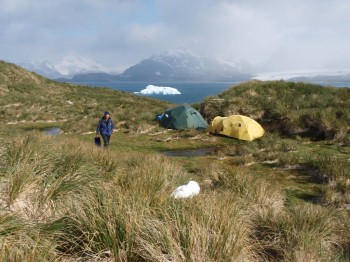
Researchers' camp site on Albatross Island
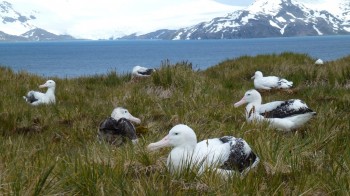
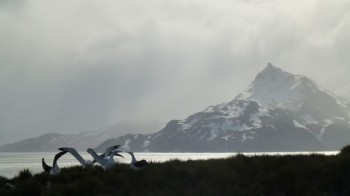
Wanderers on Albatross Island, with the main island as a backdrop
Photographs by Sally Poncet unless stated
Four to nine pairs of Light-mantled Sooty Albatrosses Phoebetria fusca have been recorded on the island from 2008 to 2103.
Study colonies on Albatross Island in January 2010 supported 35 pairs of Southern Macronectes giganteus and 27 pairs of Northern M. halli Giant Petrels. Equivalent figures for the 2012/2013 breeding season are 45 and 20. Nest failure of giant petrels in 2010 is thought to have been due to heavy snowfalls earlier in the season with many recently abandoned nests seen in January 2010 (click here). In the 1980s censuses on Albatross Island revealed 173 pairs of Southern and 89 pairs of Northern Giant Petrels. Complete-island surveys in 1999 resulted in 216 pairs of Southerns and 89 pairs of Northerns, suggesting a level of stability.
In addition to the four ACAP-listed species above, the White-chinned Petrel Procellaria aequinoctialis breeds on Albatross Island. Monitoring of this burrow-nesting species is no longer carried out on the island due to concerns over habitat damage from trampling. Antarctic Prions Pachyptila desolata, Blue Petrels Halobaena caerulea, Wilson’s Storm Petrels Oceanites oceanicus and Common Diving Petrels Pelecanoides urinatrix also breed in burrows on the island.
With thanks to Jennifer Lee, Sally Poncet and Anton Wolfaardt for information and photographs.
Selected Literature:
Burton, R. 2005. South Georgia. Second Edition. [Stanley]: South Georgia and the South Sandwich Islands. 48 pp.
Burton, R. & Croxall, J.P. (Eds). 2012. A Field Guide to the Wildlife of South Georgia. Princeton: Princeton University Press. WILDGuides & South Georgia Heritage Trust. 200 pp.
Croxall, J.P., Prince, P.A., Rothery, P. & Wood, A.G. 1998. Population changes in albatrosses at South Georgia. In: Robertson, G. & Gales, R. (Eds). Albatross Biology and Conservation. Chipping Norton: Surrey Beatty and Sons. pp. 69-83.
Galbraith, D. 2011. A Field Guide to the Flora of South Georgia. Dundee: South Georgia Heritage Trust & WILDGuides. 72 pp.
Patterson, D.L., Woehler, E.J., Croxall, J.P., Cooper, J., Poncet, S., Peter, H.-U., Hunter, S. & Fraser, M.W. 2008. Breeding distribution and population status of the Northern Giant Petrel Macronectes halli and Southern Giant Petrel M. giganteus. Marine Ornithology 36: 115-124.
Martin, A.R., Poncet, S., Barbraud, C., Foster, E., Fretwell, P. & Rothery, P. 2009. The white-chinned petrel (Procellaria aequinoctialis) on South Georgia: population size, distribution and global significance. Polar Biology 32: 655-661.
McIntosch, E. & Walton, D.W.H. 2000. Environmental Management Plan for South Georgia. Cambridge: British Antarctic Survey. 105 pp.
Pasteur, L. & Walton, D.W.H. 2006. South Georgia: Plan for Progress. Managing the Environment. 2006-2010. Cambridge: British Antarctic Survey: 74 pp.
Poncet, S. 2006. South Georgia and the South Sandwich Islands. In: Sanders, S.M. (Ed.). Important Bird Areas in the United Kingdom Overseas Territories. Sandy: Royal Society for the Protection of Birds. pp. 211-226.
Poncet, S. 2010. SGS Albatross and Prion Islands Monitoring Programme 2010 Report. Stanley: South Georgia Surveys unpublished report. 11 pp.
Poncet, S. & Crosbie, K. 2012. A Visitor's Guide to South Georgia. Second Edition. Princeton: Princeton University Press. 184 pp.
Poncet, S., Robertson, G., Phillips, R.A., Lawton, K., Phalan, B., Trathan, P.N. & Croxall, J.P. 2006. Status and distribution of wandering, black-browed and grey-headed albatrosses at South Georgia. Polar Biology 29: 772-781.
Wolfaardt, A. & Christie, D. 2010. Guidelines for the implementation of the Agreement on the Conservation of Albatrosses and Petrels (ACAP) at South Georgia and the South Sandwich Islands. Stanley: Government of South Georgia and the South Sandwich Islands. 51 pp.
John Cooper, ACAP Information Officer, 02 March 2014
*A dispute exists between the Governments of Argentina and the United Kingdom of Great Britain and Northern Ireland concerning sovereignty over the Falkland Islands (Islas Malvinas), South Georgia and the South Sandwich Islands (Islas Georgias del Sur y Islas Sandwich del Sur) and the surrounding maritime areas.


 English
English  Français
Français  Español
Español 
